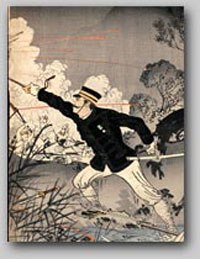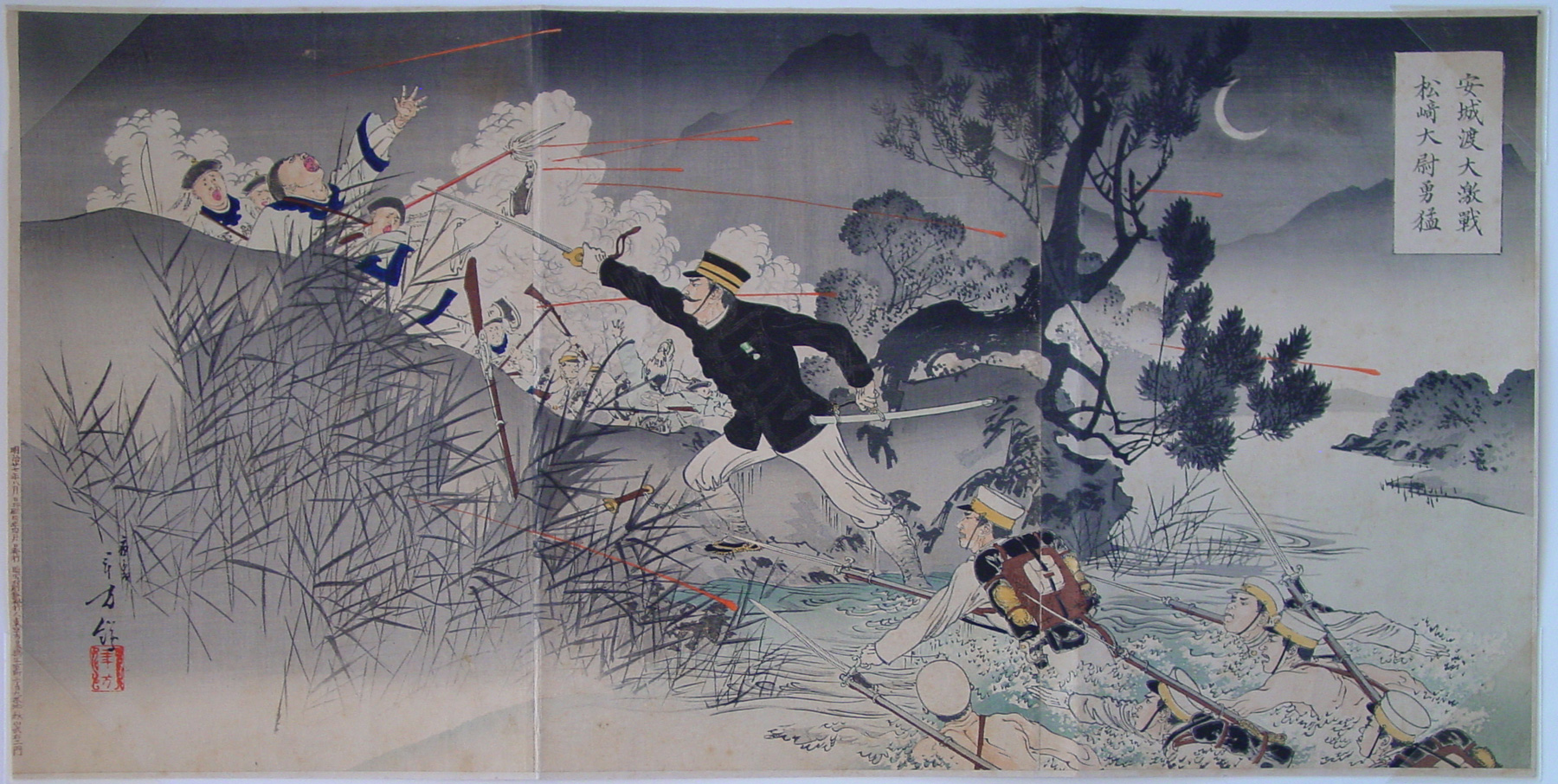About This Print
Source: In Battle's Light: Woodblock Prints of Japan's Early Modern Wars, Elizabeth de Sabato Swinton, Worcester Art Museum, 1991, p. 74.In the battle of Asan, south of Seoul, Captain Matsuzaki Naomi led his men across the deep Ansong River on July 29, 1894 to attack the enemy on the other side. He was hit, but urged his men forward, until he was killed by a second bullet. It was not the gallant officer, however, but his bugler Shirakami Genjiro1, who died blowing the charge, who became the first national hero of the campaign.
Toshikata includes all the details that convey the samurai spirit of the modern warrior. Advancing under heavy fire, undaunted by personal danger, Matsuzaki charged ahead of his men. The nighttime sky, lit by a crescent moon, heightens the pathos of the hero's bravery and death. (For a similar print by Toshikata see Captain Matsuzaki Crossing the Anjō-sen.)
1 The press incorrectly reported the bugler's name as Shirakami Genjiro. His real name was Kiguchi Kohei.
The Predictable Pose of the Hero
Source: MIT Visualizing Cultures website “Throwing Off Asia: Woodblock Prints of the Sino-Japanese War” by John W. Dower
http://ocw.mit.edu/ans7870/21f/21f.027/throwing_off_asia_02/toa_essay01.html
http://ocw.mit.edu/ans7870/21f/21f.027/throwing_off_asia_02/toa_essay01.html

Toshikata himself introduced virtually the identical hero under many different—and always real—names in his war prints. (His Japanese fighting men almost always were in movement from right to left, as if the print were a map and the viewer eye-witness to Japan’s westward advance onto the continent.) Toshikata’s archetypical hero appeared, for example, as “Lieutenant Commander Sakamoto” on the warship Akagi; as “the skillful Harada Jūkichi” in the attack on Hyonmu Gate (the sword here turned into a bayonet); as “Captain Matsuzaki” in the battle of Ansong Ford; and as “Captain Higuchi” in a near mythic battle at the “Hundred-Foot Cliff” near Weihaiwei.
The Real Captain Matsuzaki
Print Details
last revised:
(Captain Matsusaki, killed at An-song)
Overseas Images of Japan Database -
Overseas Images of Japan Database -
International Research Center for Japanese Studies, Kyoto, Japan
Print Details
| IHL Catalog | #168 |
| Title or Description | The Great Battle of the Ansong Ford: The Valor of Captain Matsuzaki Crossing Anjō or Captain Matsuzaki Fighting at An-ch'eng (Anjō-watashi daigekisen Matsuzaki Taii yūmō 安城渡大激戦松崎大尉勇猛) |
| Artist | Mizuno Toshikata (1866-1908) |
| Signature |  |
| Seal | Toshikata (as shown above) |
| Publication Date | August 1894 (Meiji 27) |
| Publisher | 秋山武右エ門 (秋山武右衛門) Akiyama Buemon |
| Impression | excellent |
| Colors | excellent |
| Collection | good - light foxing throughout; trimmed but not into image with left border writing intact; two vertical folds near, but not on, joining seams; backed |
| Genre | ukiyo-e - senso-e (Sino-Japanese War) |
| Miscellaneous | |
| Format | vertical oban triptych |
| H x W Paper | 14 1/4 x 28 3/8 in. (36.2 x 72.1 cm) |
| Literature | In Battle's Light: Woodblock Prints of Japan's Early Modern Wars, Elizabeth de Sabato Swinton, Worcester Art Museum, 1991, p. 74, pl. 40; Japan Awakens: Woodblock Prints of the Meiji Period (1868-1912), Barry Till, Pomegranate Communications, Inc., 2008, p. 103 |
| Collections This Print | Museum of Fine Arts, Boston 65.417a-c, 2000.115a-c and 2000.436a-c; Art Gallery of Greater Victoria 2004.026.059; Harvard University Museums 1944.25.1, .2, .3; The British Museum 1941,1010,0.1.1-3; Smithsonian National Museum of Asian Art S1999.75a-; Honolulu Academy of Art 2397; Östasiatiska musee OM-1994-0027; British Library shelfmark: 16126.d.3(30) |
3/11/2020
11/10/2018



